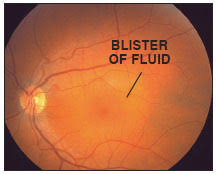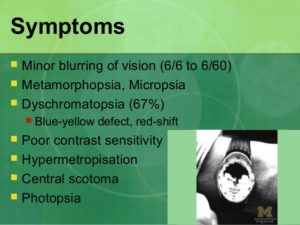Central serous retinopathy (also called choroidopathy) is a relatively common condition in which a “blister” of fluid forms under the retina (serous retinal detachment). Since this “blister” forms in the center of the retina and affects central vision, the condition has been appropriately named central serous retinopathy (CSR).
The leakage is usually localized, but can be extensive. Individuals between the ages of 20 and 55 may develop this condition. Men are 10 times more likely than women to develop this condition. The typical symptoms may include blurred vision, distortion, altered color perception, reduced image size, and a central blind spot. The onset of symptoms is usually sudden. Vision may vary from 20/20 to 20/400.
The cause of CSR is unknown. Individuals with “hard-driving, type-A personalities” are more prone to develop this condition. On that basis, stress has been suggested as a possible cause, although this has never been proven.
Treatment
Treatment is usually not necessary because nearly 90% of individuals spontaneously recover 20/30 vision or better. The recovery usually occurs in one to six months. After recovery, some patients may still detect subtle visual deficits. For those patients in whom CSR does not resolve, laser eye surgery can be performed. Recurrences in the affected eye or the fellow eye are not uncommon.
The fluorescein angiogram test, or dye injection test, is invaluable in making the diagnosis, differentiating CSR from more serious problems, and in following atypical or prolonged cases.

